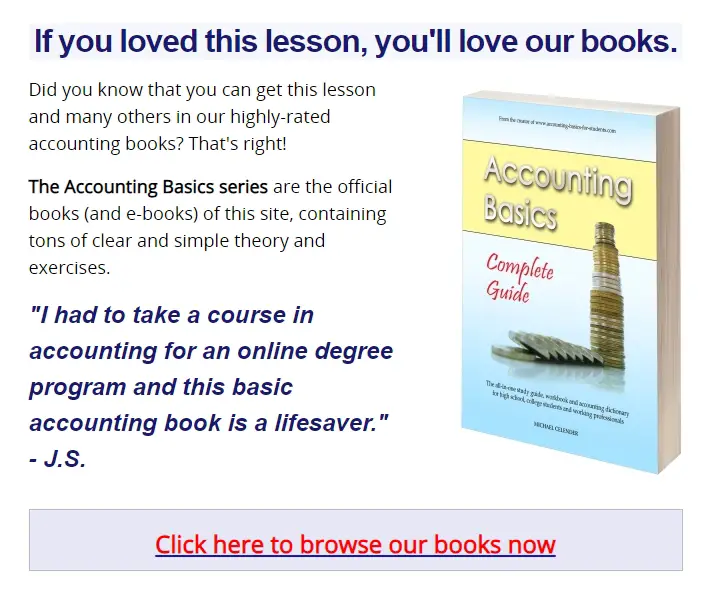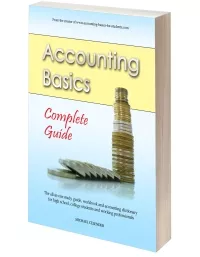Asset Purchase Example
Previous lesson: Accounting Equation: Liability Examples
Next lesson: Drawings Example
In this lesson we're going to cover an example of purchasing an asset. Just as with the previous lessons, we'll use our sample business, George's Catering, to illustrate the transaction.
Be sure to check your understanding of this lesson by taking the quiz in the Test Yourself! section further below. And right at the bottom of the page, you can find more questions on the topic submitted by fellow students.
Please note: This lesson is an introductory tutorial for an asset purchase transaction, showing the accounts that are affected as well as the overall effect on the basic accounting equation - but without the journal entry.
For a more in-depth tutorial on purchasing an asset, including the debit and credit journal entry, see the advanced tutorial: Journal Entry for Asset Purchase.
So far George has financed his business through his own funds ($15,000 capital) as well as through a loan from the bank ($5,000). He has $20,000 in his bank account available to spend.
The accounting equation for George's Catering stood as follows:

Now, what is he going to do with his funds?
Asset Purchase Transaction Example
c) George decides to actually set up his business. He decides to buy some baking equipment for his catering, so that he can bake various foods. The equipment costs $12,000. He pays this in cash.
Okay, so what the hell happens now with our accounting equation?!
I know - it's getting a bit more complex. Don't worry, don't panic...
Just as with our previous example, the easiest part of the transaction and a good starting point is to ask yourself what happened to the cash we had in our bank account.
We had $20,000. But now we're spending $12,000. So cash is decreasing by that amount.
The other part of the transaction is that we are gaining the kitchen equipment. Since this is an item of value that will provide the business future benefits, it is also an asset.
An asset like kitchen equipment is one which we plan to use over a number of years. Did you know that a long-term tangible asset, like this kitchen equipment, has a specific name? It's known as a fixed asset.
In order to simplify things, let's analyze the assets of George’s Catering before and after the transaction, as well as the changes that occurred:
As you can see, we are essentially ‘swapping’ one asset for another.
The total of the assets does not change, only the value of the individual assets.
Our accounting equation is affected as follows:
The owner still owns $15,000 of the $20,000 assets. External parties still have a claim of $5,000 of the business’s assets. The only thing that has changed is the mixture of assets.
George’s Catering still consists of assets of $20,000, but this is now made up of baking equipment to the value of $12,000, and $8,000 cash. Previously it was $20,000 cash and nothing else.
Want to see the full journal entry for this transaction?
Test Yourself!
Before you start, I would recommend to time yourself to make sure that you not only get the questions right but are completing them at the right speed.
Difficulty Rating:
Beginner
Quiz length:
3 questions
Time limit:
5 minutes
Important: The solution sheet on the following page only shows the solutions and not whether you got each of the questions right or wrong. So before you start, get yourself a piece of paper and a pen to write down your answers. Once you're done with the quiz and writing down your answers, click the Check Your Answers button at the bottom and you'll be taken to our page of solutions.
Good luck!
Okay! So that's it for our asset purchase example, where we learned what would happen if we purchased a fixed asset (or non-current asset).
I hope that transaction is clearer now!
If you are having any difficulty with understanding the example above, return to the lesson entitled What are Assets? to review this key concept.
Return from Asset Purchase Example to Basic Accounting Transactions
Return to the Home Page
Stay up to date with ABfS!
Follow us on Facebook:
Previous lesson: Accounting Equation: Liability Examples
Next lesson: Drawings Example
Questions Relating to This Lesson
Click below to see questions and exercises on this same topic from other visitors to this page... (if there is no published solution to the question/exercise, then try and solve it yourself)
Asset Appreciation Journal Entry Example
Q: Becks introduced his van into the business $30,000. What is the amount to enter in capital account if it was $36,000 on 1 Jan?
A: From what I …
Asset Classification & Cashier's Check
Q: I bought a business warehouse. How do I classify this asset if I paid the full amount with a cashier's check?
A: This is a pretty simple transaction …
© Copyright 2009-2023 Michael Celender. All Rights Reserved.
Click here for Privacy Policy.









Comments
Have your say about what you just read! Leave me a comment in the box below.